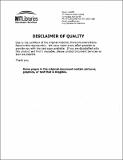The determinants of REIT franchise value : a reprise
Author(s)
Santos, Rossana
DownloadFull printable version (3.856Mb)
Other Contributors
Massachusetts Institute of Technology. Dept. of Architecture.
Advisor
W. Tod McGrath.
Terms of use
Metadata
Show full item recordAbstract
This paper re-examines the determinants of REIT franchise values, which were defined and studied in a previous MIT thesis by Jim Young for a representative group of apartment and office REITs in 1998. Franchise value was specifically defined as the Premium-to-Net Asset Value (NAV) at which most REITs trade. In broader terms, franchise value is often defined as the present value which management is expected to add in terms of net revenue growth to shareholders. A more specific definition of franchise value was presented in the previous thesis, and a model constructed, in which the internal and external structural components were quantified, to determine their impact on franchise value. The same econometric model is applied today to pooled data from '97 and '99, against the backdrop of a different market environment, to verify which components continue to play a significant role on a REIT's franchise value over a broader market cycle. Independent variables are developed as proxies for the components of the franchise value, and are regressed against alternate specifications of franchise value (the dependent variable). The dependent variables used in this study are the REITs' Premium-to-Net Asset Value (NAV) and Price to Funds From Operations (FFO) multiple for the sample of office and apartment REITs. The results show that regional economic concentrations, measures of balance sheet strength, visibility, management experience and conflict of interest mitigations are statistically significant factors which contribute to franchise value. More significantly, this thesis discovered that the relationship between the alternate specification of the dependent variable, the Price-to-FFO multiple, and the independent variables is more conclusive than it is for the Premium-to-NAV specification of the dependent variable. This suggests that perhaps over time, the more objective measure of the Price-to-FFO multiple produces a better measure of franchise value than does the more commonly used Premium-to-NAV (which is a more subjective measure of a REIT's portfolio value, and depends on a multitude of assumptions for which there is little consensus at the present time).
Description
Thesis (S.M.)--Massachusetts Institute of Technology, Dept. of Architecture, 2000. Includes bibliographical references (leaves 46-47).
Date issued
2000Department
Massachusetts Institute of Technology. Department of ArchitecturePublisher
Massachusetts Institute of Technology
Keywords
Architecture.